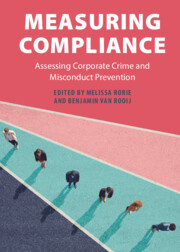Book contents
- Measuring Compliance
- Measuring Compliance
- Copyright page
- Contents
- Figures
- Tables
- Contributors
- 1 Measuring Compliance: The Challenges in Assessing and Understanding the Interaction between Law and Organizational Misconduct
- Part 1 The Compliance Industry, the State, and Measurement Needs
- Part 2 Quantitative Approaches to Measuring Corporate Compliance
- 5 Self-Report Surveys and Factorial Survey Experiments
- 6 The Use of Randomized Experiments for Assessing Corporate Compliance
- 7 Measuring Corporate Compliance: A Guide to Using Available Firm Data to Improve Employee Behavior
- 8 Measuring Compliance Risk and the Emergence of Analytics
- 9 Using Regulatory Inspection Data to Measure Environmental Compliance
- 10 Using Outcomes to Measure Aggregate-Level Compliance – Justifications, Challenges, and Practices
- Part 3 Qualitative Approaches to Measuring Corporate Compliance
- Part 4 Mixed Methods and Building on Existing Compliance Research
- Index
- References
10 - Using Outcomes to Measure Aggregate-Level Compliance – Justifications, Challenges, and Practices
from Part 2 - Quantitative Approaches to Measuring Corporate Compliance
Published online by Cambridge University Press: 17 February 2022
- Measuring Compliance
- Measuring Compliance
- Copyright page
- Contents
- Figures
- Tables
- Contributors
- 1 Measuring Compliance: The Challenges in Assessing and Understanding the Interaction between Law and Organizational Misconduct
- Part 1 The Compliance Industry, the State, and Measurement Needs
- Part 2 Quantitative Approaches to Measuring Corporate Compliance
- 5 Self-Report Surveys and Factorial Survey Experiments
- 6 The Use of Randomized Experiments for Assessing Corporate Compliance
- 7 Measuring Corporate Compliance: A Guide to Using Available Firm Data to Improve Employee Behavior
- 8 Measuring Compliance Risk and the Emergence of Analytics
- 9 Using Regulatory Inspection Data to Measure Environmental Compliance
- 10 Using Outcomes to Measure Aggregate-Level Compliance – Justifications, Challenges, and Practices
- Part 3 Qualitative Approaches to Measuring Corporate Compliance
- Part 4 Mixed Methods and Building on Existing Compliance Research
- Index
- References
Summary
Abstract: Laws, rules, and regulations are intended to achieve goals, and the measurement of compliance is thought of as a way to verify if they function as intended. In this perspective, it may make sense to try and see not only whether and to what extent rules are complied with – but whether intended outcomes are achieved. In particular, the purpose of the chapter is measuring aggregate (rather than individual) compliance through outcomes measurement, and thus seeing the extent to which the entire regulatory system is functioning “as intended.” This contribution takes specifically the angle of outcomes measurement as proxy for the aggregate compliance level of regulated entities, providing an instrument to assess the performance of the regulatory system as a whole. Looking at several major regulatory fields, outcomes can be defined in terms of direct, physical-world results (occupational health and safety, food safety, environmental protection). The chapter also considers what the challenges are for the use of aggregate outcome data, how these can be managed, and what the practices of some leading regulatory agencies or services are. Often, these combine compliance measurement (direct) and outcomes measurement in order to compensate for each of the shortcomings and limitations of these approaches. Finally, the chapter briefly considers the obstacles and possible ways forward in applying “aggregate outcomes measurement” approaches – and the specific difficulties in using them in certain regulatory domains.
Information
- Type
- Chapter
- Information
- Measuring ComplianceAssessing Corporate Crime and Misconduct Prevention, pp. 168 - 186Publisher: Cambridge University PressPrint publication year: 2022
